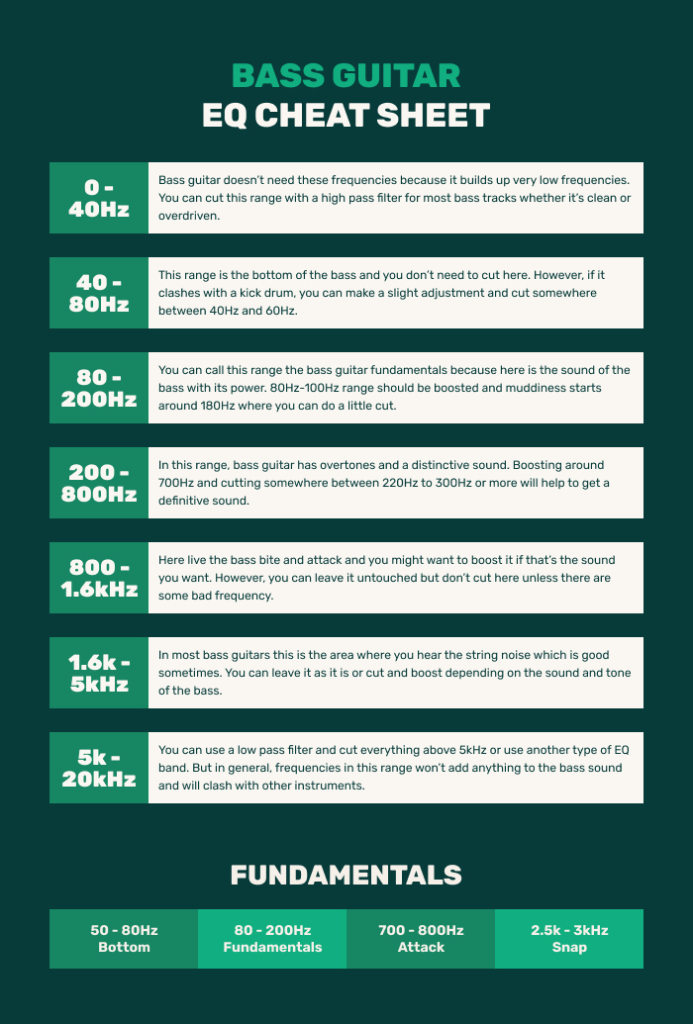When it comes to mixing bass guitars, getting the right sound is critical no matter the genre.
That’s why, whether you want a clean or distorted tone, knowing which frequencies to focus on and which to cut is important.
Knowing the bass guitar’s frequency range is critical to unlocking its full potential and achieving the perfect tonal balance.
And for that, having a bass guitar EQ cheat sheet is a good idea because not only it acts as a guide, but it’s also a great learning source.
Bass Guitar Frequencies
I created this bass guitar EQ cheat sheet for beginners and intermediate mixing engineers but it can be useful for professionals too. It will help you to mix bass guitar more confidently.
- 0-40Hz – Since the bass guitar generates low frequencies naturally, there’s no need for these frequencies to be present in the audio signal. One can simply use a high pass filter to eliminate this range from most bass tracks, whether they are clean or overdriven.
- 40-80Hz – A lower end of the bass falls within this particular frequency range, and it’s generally not necessary to reduce it. However, if it conflicts with the kick drum, you could consider making a minor alteration by cutting somewhere between the frequencies of 40Hz to 60Hz.
- 80-200Hz – The frequency range between 80Hz and 100Hz is often referred to as the bass guitar fundamentals as it contains the powerful sound of the bass. Boosting this range can enhance the overall tone. On the other hand, if you encounter any muddiness in the sound, it’s recommended to make a slight cut in the 180Hz range.
- 200-800Hz – Bass guitars produce distinct harmonics and tonal qualities within this specific frequency range. By increasing the volume to around 700Hz and decreasing it from around 220Hz to 300Hz (or potentially even lower), you can achieve a more definitive and recognizable sound.
- 800-1600Hz – If you want a bass sound with bite and attack, you may consider increasing the levels in this frequency range. However, it’s also okay to leave it as is but avoid reducing it unless there are unwanted frequencies causing issues.
- 1600-5000Hz – The location where you typically perceive string noise in bass guitars is usually considered beneficial, although it depends on personal preference. You have the option to maintain the natural sound or adjust it to your liking by decreasing or increasing the level in that frequency range.
- 5000-20000Hz – One option is to employ a low pass filter to eliminate all frequencies above 5kHz, or you can experiment with different types of EQ bands. However, it’s worth noting that frequencies within this range typically do not contribute to the bass sound and can potentially cause interference with other instruments.

Conclusion
So, this bass guitar EQ cheat sheet gives you the frequencies that are essential when mixing bass guitars. It will help you to create better mixes with a great bass sound.

The author’s passion for the topic shines through in every word.
Thanks, Audrina. I appriciate it.
The writing style on this site is captivating. It keeps me hooked from the first sentence to the last.
Thanks, Audrina.
You’re so awesome! So great to find someone with some original thoughts on this topic.
Thanks a lot, Ryker.
Pretty! This has been a really wonderful post. Many thanks for providing these details.
Thanks you Jimmy. I’m glad that my post was helpful.
Wow, this is a great website! The layout is user-friendly and visually appealing. Thank you for sharing such valuable information!
Thank you for reading my article. I am happy that you find it interesting.
Hi there to all, for the reason that I am genuinely keen of reading this website’s post to be updated on a regular basis. It carries pleasant stuff.
Thanks, Amya
Nice post. I learn something totally new and challenging on websites
Good post! We will be linking to this particularly great post on our site. Keep up the great writing
Thanks a lot.
I am truly thankful to the owner of this web site who has shared this fantastic piece of writing at at this place.
Thanks
This is my first time pay a quick visit at here and i am really happy to read everthing at one place
Thanks.